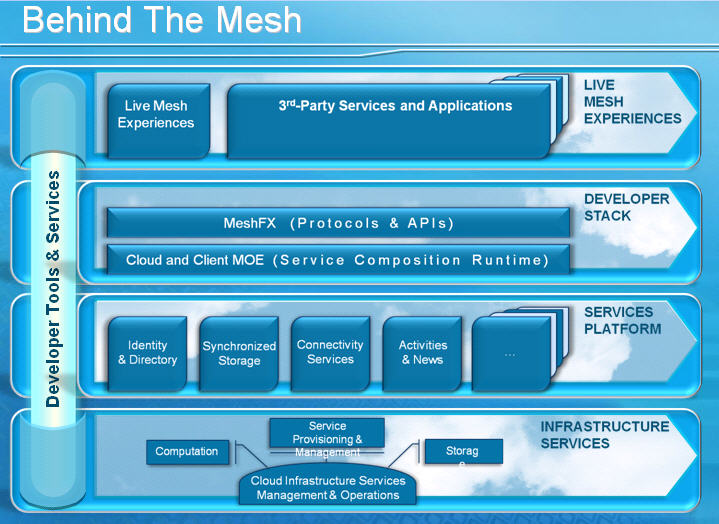Microsoft's Live Framework: A (revised) picture is worth a thousand words

Microsoft's Live Framework has evolved a bit since the company first unveiled it in April this year.
Microsoft is now positioning the Live Framework as the development framework for all of Microsoft's Live services, not just Live Mesh. The Live Framework is akin to the .Net Framework, but is aimed to support developers writing mostly consumer-focused applications and services that need online/offline synchronization and work across the PC, Web and devices.
Here at Microsoft Professional Developer Conference (PDC), Microsoft announced that its Live Framework is now "live," as in Microsoft allowing developers to sign up to test drive it.
Microsoft also made some tweaks to the framework since it first unveiled plans for it. Some of the names of the different subsystems within the framework are different. And the way that Live Mesh and Silverlight work together has been fleshed out. The Framework now includes support for contacts, so that developers can build applications that will be designed to spread virally.
"We're unleashing (contacts) in the platform. We're making social-graph information available to developers to help them make their applications viral," said Jeff Hansen, General Manager Services Marketing.
Here's what the Live Framework looked like in April:
And here's what the Live Framework looks like now:
The infrastructure services layer, even though it's not visible in the newly revised slide, remains the same: It's Windows Azure (Red Dog) and the building-block Azure services. The Mesh FX (framework) is now simply called the "programming model." The Mesh operating environment (MOE) is now the Live Operating Environment (LOE?). The operating environment consists of three pillars: Data, applications and communications.
(If you're a real architectural diagram junkie, here's an even more detailed overview of what the Live Framework looks like under the covers.)
"We want to make it easy for rich applications to extend to the cloud. But we also want to help Web apps break free of the browser frame and go offline," explained Abhay Parasnis, General Manager of Live Mesh. "We also want to enable developers of applications inject social-graph data into their applications."
Developers are going to be able to wrap a Silverlight application with an "invisible" Internet Explorer wrapper and publish an application to Mesh. Through the Mesh synchronization model, developers can enable their applications to run locally on any Mesh-enabled system or device. When users reconnect and go online, these local Silverlight apps will automatically synchronize.
So what's next for Mesh? Microsoft will be moving more of its Live services onto the base Red Dog cloud operating system, officials said. Right now, Live Mesh is the first of those services that is (partially) hosted in Microsoft's cloud. Microsoft also will continue to extend its base Live Services platform. Right now, that platform consists of shared identity; directory; communication and presence; search and geospatial; and contacts. Expect Live Workspaces, groups, calendars and other core elements to be added to the platform in the coming months.
